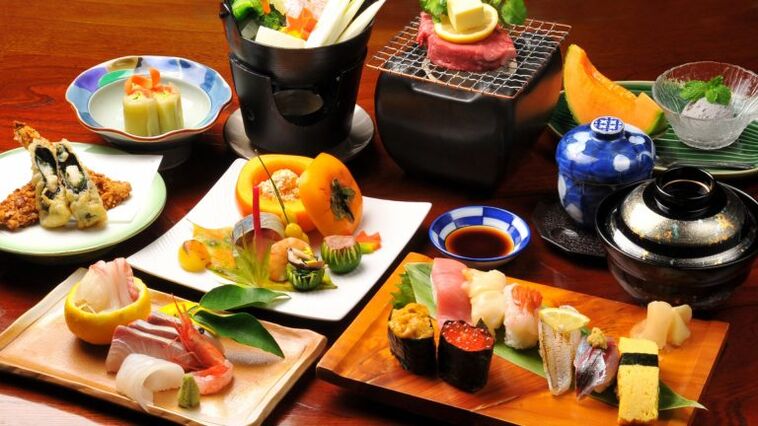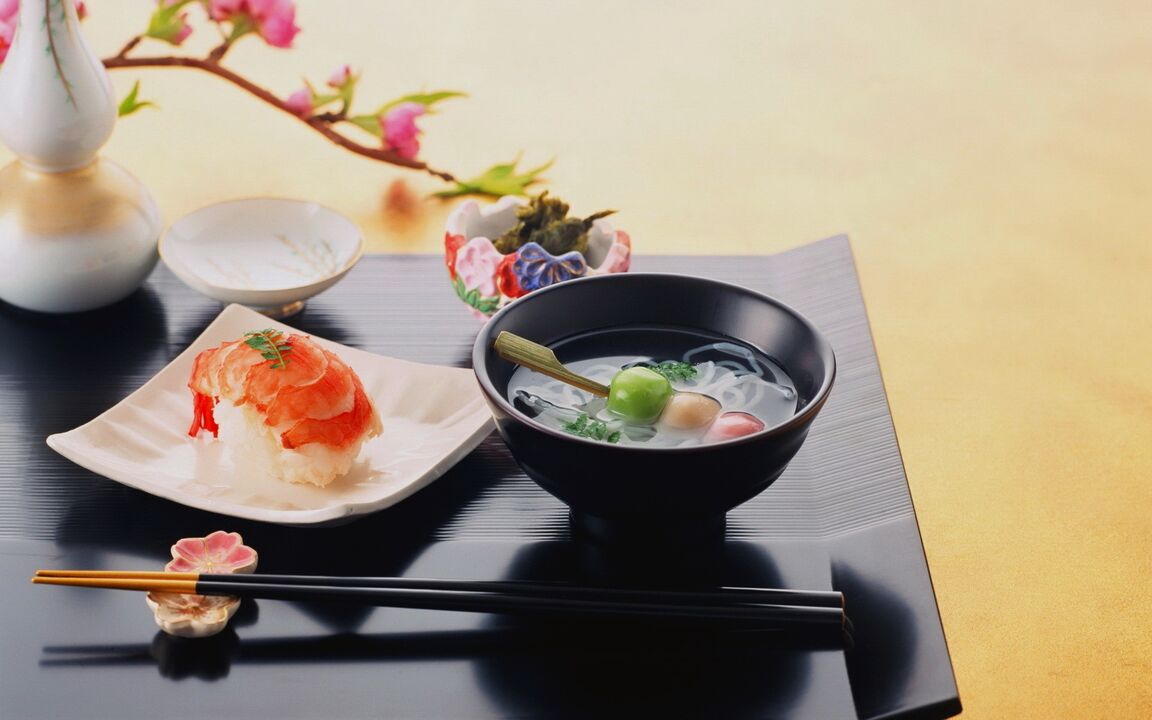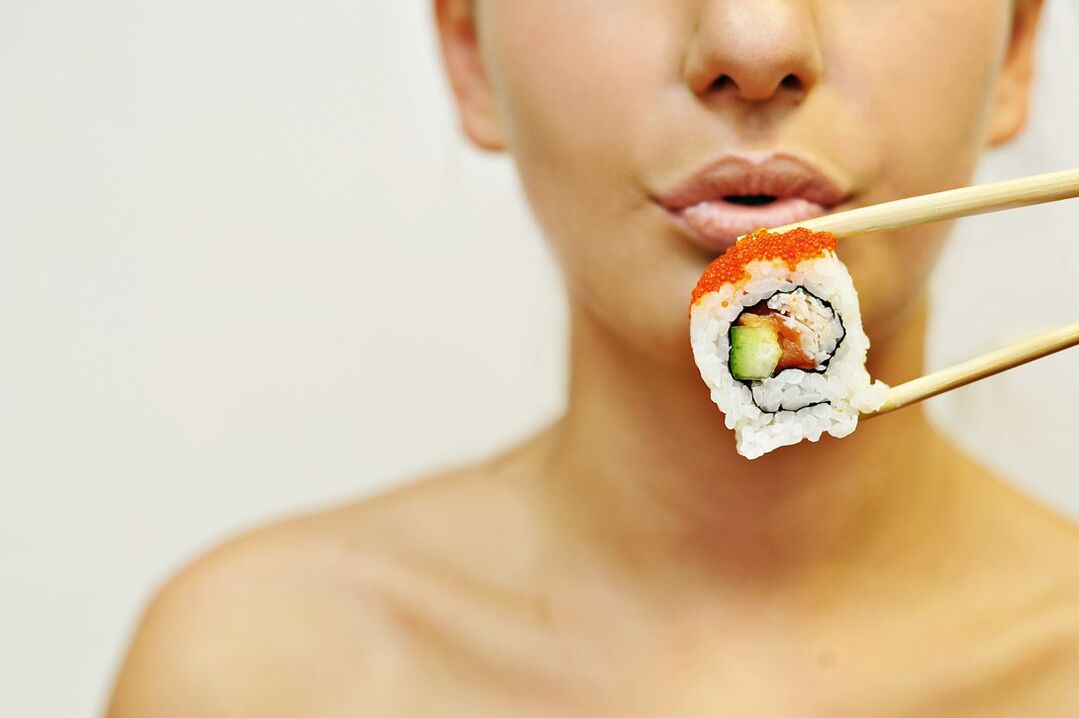In recent years, the Japanese diet has gained great popularity, which simultaneously combines both fast results and benefits for the body. Moreover, the main feature of this 2-week feeding plan is that it does not have e. წ. rollback, when everything returns to normal after 2-3 weeks.
Japanese food is becoming increasingly popular thanks to the growing popularity of Japanese cuisine in indoor cafes and restaurants. Nowadays you can buy rolls or everything you need to prepare them in almost any kitchen. What is the Japanese diet for weight loss?

The main features of the Japanese diet for 14 days
Let's review the Japanese diet for weight loss and what principles it is based on:
- The total duration is 14 days;
- Low carb, low carb, high protein foods. Requires discipline and endurance;
- Total cost - not more than 2000 rubles for the whole cycle;
- Estimated results are 5 to 8 kg;
- Repeatability - no more than twice a year;
- Stability - high, in case of correct exit two weeks after the ration, the result is maintained for a long time and without recurrence;
- Contraindications: pregnancy, lactation, diseases of the gastrointestinal tract (ulcers, gastritis, gastroduodenitis, etc. ), kidney and liver diseases. It is also not recommended in the presence of heart problems. It is advisable to consult before starting a diet
Japanese diet for weight loss - a thriving trend or real effectiveness?

The Japanese diet was previously completely unknown. Moreover, the concept of the "diet" meant a serious reduction in food and calories, including starvation, and despite the popularization of this unique diet plan, many still believe that the Japanese diet for 14 days consists of sushi, green tea and of course rice. This diet should not be judged only by traditional Japanese cuisine, in just two weeks it will remind you of sea fish, eggs and green tea - products that are found in many countries around the world, which is a great advantage of the diet becauseDigestive disorders or even allergies.
It is not yet known exactly how the Japanese 14-day diet relates to the land of the rising sun. According to some reports, it was developed in one of the Japanese clinics, others believe that this nutrition plan was attributed to Japan because of its strict discipline, menu and efficiency. However, it does not matter where this diet came from, as it is that it is incredibly effective and harmless if you follow it properly.
As in any case, the Japanese menu involves reducing calories in the diet. It is based on traditional Japanese cuisine, known for its lack of fatty foods, abundance of vegetables and fish. One of the famous public figures and nutritionist Naomi Moriam believes that nutrition is the secret of Japanese women who maintain beauty and a slim figure until old age. The main, he said, are low carbohydrates and small portions.
Naomi calculates that Japanese people consume 25% fewer calories than people living in other countries. For example, with an abundance of different foods and so-called fast food, chips, chocolate bars, fatty pastries and even butter are not particularly popular in Japan. Even "street food" is low in calories and low in fat and carbohydrates. Therefore, the Japanese diet menu is fully in line with the food culture, traditions and basics of the diet in the country.
Proper diet is essential for fat burning! But think about it, what kind of result do you want to get in the end? Are you sure you will see a toned and strong body after getting rid of the fat layer? You need the right exercise to build muscle tone and gain sexual volume! And to make it easier for you, we offer a ready-made curriculum diagram!
The concept and basic rules of the Japanese diet

The sizes of some residents of the CIS and Japan are significantly different, so for many, a sharp jump can be a real test. But do not worry, as this plan is designed for two weeks, after which you may be able to slowly return to your usual diet and favorite foods.
Protein will be the basis and source of saturation in your diet. You can get it only from the following products:
- Თევზი;
- eggs;
- მისHeart - chest;
- Milk products;
- Lean beef.
Only crackers and a few vegetables will go for carbohydrates. For fats - olive oil. Also, fats are found in fish and other protein products, this will prevent deficiency. The Japanese 14-day diet menu and scheme with significant restrictions on calories, especially carbohydrates, can be a real challenge. Nevertheless, it should be noted that the body quickly adapts to such a diet and the next week will not be so difficult.
It is important to note that a healthy amount of fiber is present in the menu in sufficient quantities. It is found in vegetables that can be eaten almost without restriction (only on some days). It eliminates any gastrointestinal problems and improves digestion. The diet also includes green tea and coffee. They not only help you to stay alert and tired, but also provide the body with large amounts of antioxidants. It is important that the tea is natural, without dyes and flavors, and it is advisable to buy coffee in beans and grind it yourself.
By looking at the 14-day menu of the Japanese diet, you can be sure that all the nutrients are in this diet plan, and major changes have affected mainly the portion size and the amount of food consumed. Basically, for most people, two weeks pass without any results, but if your body has reacted very strongly to the reduction of carbohydrates, then you should postpone the diet for the future and consult a doctor. The main symptoms will be headache, severe weakness and fatigue.
Drinking regime is of great importance. You should drink plenty of plain water at room temperature. First of all, it will help improve digestion and deal with hunger more easily by simulating a full stomach. Secondly, it allows you to remove protein processing products from the body. Another important point is the strict adherence to the general plan. If you seriously decide to try and test how to lose weight on a Japanese diet, then you should eat only those foods and the amount that is provided each day. Replacement is not allowed. You also can not change or change the days.
The only exceptions are coffee and tea. In the morning, instead of coffee, you can drink a cup of tea, for personal preference. Sugar free, of course. Salt is also a negative factor in the diet, but if you can not completely eliminate it, limit it to a minimum.
One of the major drawbacks, apart from the low calorie content, is also considered to be the small number of meals. While other diets include 5 or even 8 meals a day, the Japanese diet includes only 3 meals. We must also remember that you should start the day with a glass of water, it will "start" the body and metabolic processes. Dinner should be eaten no earlier than 2-3 hours to digest food during sleep.
This is a strict diet, so a smooth entry is recommended with the exception of reducing transitions in the diet. So the body will quickly adapt to the new conditions and the diet will be more comfortable. The easiest way to prepare will be to completely stop fast food at least 3-5 days before the start of the diet, as well as reduce portions (by eating no more than half the usual volume). Although this scheme may seem too rigid, it is completely balanced and does not harm the body, but at the same time allows you to lose 5-8 kg in just 2 weeks.
Preparatory period and grocery shopping

You will need:
- Coffee (ground or cereal) - 1 pack;
- Natural green tea - 1 pack;
- Chicken eggs - 20 pieces;
- Lean beef (pulp) - 1 kg;
- Sea fish (fillet) - 2 kg;
- Chicken fillet - 1 kg;
- Extra Virgin Olive Oil - 0, 5 l;
- Carrots - 2-3 kg;
- White cabbage - 2 pieces of medium size;
- Eggplant or zucchini - 1 kg;
- Fruits (except grapes and bananas) - 1 kg;
- Kefir - 1 liter;
- Tomato juice - 1 liter;
- Lemon - 2 pcs.
In terms of principles and diet, the Japanese diet is often compared to the "chemical diet" - a diet plan developed in the United States by Osama Hamdi, whose diet is actively used to treat diabetes and obesity. Intake, which changes the chemistry of metabolic processes in the body, causing chain reactions that lead to drastic weight loss. However, there is one important difference between these diet plans. The Osama Hamdiya system includes an unlimited number of products that allow you to count on building muscle and vigorous exercise. , The Japanese scheme has a strict quantitative limit and a short period of only two weeks. This is a plus for those who want to get a quick result and can not deplete the body for months, avoiding the usual diet.
Detailed menu of Japanese diet every day

It is important to take this scheme very seriously, strictly adhering to the recommendations. Any attempt to break the scheme or add products may result in a worse-than-expected overall result. The menu for each day of the Japanese diet for 14 days is as follows:
Day number 1
- Breakfast - pure coffee without milk and sugar;
- Lunch - boiled egg (2 pcs. ), Boiled cabbage with olive oil, 1 cup of tomato juice;
- Dinner - 200 grams of fried or boiled fish.
Day number 2
- Breakfast - coffee and 1 slice of rye bread;
- Lunch - 200 g of fried or boiled fish with boiled cabbage and olive oil;
- Dinner - 100 g of boiled beef and 1 cup of kefir.
Day number 3
- Breakfast - a slice of rye bread (dried in a toaster) or biscuit without additives. ჯ cup of coffee;
- Lunch - fry eggplant or zucchini in olive oil (any portion size);
- Dinner - Boil 200 g of beef unsalted, fresh cabbage with olive oil, 2 boiled eggs.
Day number 4
- Breakfast - one fresh small carrot with the juice of one lemon;
- Lunch - 200 g of fried or boiled fish, 1 glass of tomato juice;
- Dinner - 200 g of fruit (any).
Day number 5
- Breakfast - one medium-sized carrot with whole lemon juice;
- Lunch - boiled or steamed fish with a glass of tomato juice;
- Dinner - 200 grams of fruit (any).
Day number 6
- Breakfast - a cup of sugar-free coffee;
- Lunch - boiled chicken without salt (500 g), fresh carrot and cabbage salad (season with olive oil);
- Dinner - one fresh carrot and 2 boiled eggs.
Day number 7
- Breakfast - a cup of green tea;
- Lunch - boiled beef unsalted (200 g);
- Dinner - your choice: 200 g of fruit, 200 g of boiled beef with a glass of kefir, 200 g of boiled fish or 2 boiled eggs with salad (carrots baked in olive oil.
Day number 8
- Breakfast - one cup of coffee;
- Lunch - 500 g of boiled chicken with salt, cabbage and carrot salad (season with olive oil);
- Dinner - one small carrot in olive oil, 2 boiled eggs.
Day number 9
- Breakfast - one carrot with whole lemon juice;
- Lunch - 200 g of fried or boiled fish and one glass of tomato juice;
- Dinner - 200 g of fruit of your choice.
Day number 10
- Breakfast - a cup of coffee;
- Lunch - 3 small carrots (fry in vegetable oil), 1 egg and 50 g of cheese;
- Dinner - 200 g of any fruit.
Day number 11
- Breakfast - a cup of coffee and 1 slice of rye bread;
- Lunch - fry eggplant or zucchini in olive oil (in any quantity);
- Dinner - 200 g of boiled beef, fresh cabbage with olive oil, 2 boiled eggs.
Day number 12
- Breakfast - a cup of coffee and a slice of rye bread;
- Lunch - 200 g of fried or boiled fish, fresh cabbage with olive oil;
- Dinner - 100 g of boiled beef and 1 cup of kefir.
Day number 13
- Breakfast - a cup of coffee;
- Lunch - 2 boiled eggs, boiled cabbage with olive oil and 1 glass of tomato juice;
- Dinner - fry 200 g of fish in olive oil.
Day number 14
- Breakfast - a cup of coffee;
- Lunch - fried or boiled fish, fresh cabbage with olive oil;
- Dinner - 200 grams of cooked beef, 1 cup of kefir.
There is an opinion that this diet allows you to get the longest and most stable result without returning to your usual weight. After weight loss it is possible to maintain weight for up to 3 years, but only on condition that you strictly follow the diet and do not start compensating for everything with high-calorie food after 15 days. Also, adapting your Japanese diet plan to your daily diet would be a great solution.













































